A Fast Evaluation Method for Electrical Performance of Frequency and Pattern Reconfigurable Microstrip Antenna Based on Electromechanical Coupling
Abstract
:1. Introduction
2. Establishment of an Electromechanical Coupling Model for a Frequency and Pattern Reconfigurable Microstrip Antenna
2.1. Ideal Reconfigurable Microstrip Antenna Electromechanical Coupling Model
2.1.1. Antenna Resonance Frequency Coupling Model Based on Transmission Line Model Theory and Equivalent Current Distribution
2.1.2. Antenna Pattern Coupling Model Based on Cavity Model Theory and the Mutual Coupling Effect
2.1.3. Field Distribution Calculation of the Patch Element Based on the Cavity Model
2.1.4. Reconfigurable Antenna Pattern Function Coupling Model Considering Mutual Coupling
2.1.5. Solution of Patch Excitation Current
- Patch element excitation mode judgment
2.2. Reconfigurable Microstrip Antenna Coupling Model Considering Structural Deformation
2.3. Accuracy and Applicability Analysis of Reconfigurable Microstrip Antenna Coupling Model
3. Experimental Verification of the Electromechanical Coupling Model of a Reconfigurable Microstrip Antenna
3.1. Experimental Scheme
3.2. Test and Verification of the Resonant Frequency Coupling Model
3.3. Test and Verification of Pattern Function Coupling Model
3.4. Discussion of Results
4. Conclusions
Author Contributions
Funding
Conflicts of Interest
References
- Zhang, S.; Zeng, Q.; Shang, Y.; Wu, Y. An overview of antenna reconfiguration technologies: Overview of Reconfigurable Antenna. In Proceedings of the 2019 International Conference on Information Technology and Computer Application (ITCA), Guangzhou, China, 20–22 December 2019; pp. 25–28. [Google Scholar]
- Qin, P.; Wang, Q.-Y.; Fu, J.-H.; Li, C.-W.; Zhang, C.-L.; Liu, T.-Y.; Gui, L.; Liu, J.; Deng, Z.S. A U-Shaped Dual-Frequency-Reconfigurable Monopole Antenna Based on Liquid Metal. Materials 2022, 15, 1599. [Google Scholar] [CrossRef] [PubMed]
- Dildar, H.; Althobiani, F.; Ahmad, I.; Khan, W.U.R.; Ullah, S.; Mufti, N.; Ullah, S.; Muhammad, F.; Irfan, M.; Glowacz, A. Design and Experimental Analysis of Multiband Frequency Reconfigurable Antenna for 5G and Sub-6 GHz Wireless Communication. Micromachines 2021, 12, 32. [Google Scholar] [CrossRef] [PubMed]
- Deng, Z.; Guo, X.; Wei, H.; Gan, J.; Wang, Y. Design, Analysis, and Verification of Ka-Band Pattern Reconfigurable Patch Antenna Using RF MEMS Switches. Micromachines 2016, 7, 144. [Google Scholar] [CrossRef] [PubMed]
- Anagnostou, D.E.; Chryssomallis, M.T.; Goudos, S. Reconfigurable Antennas. Electronics 2021, 10, 897. [Google Scholar] [CrossRef]
- Ojaroudi Parchin, N.; Jahanbakhsh Basherlou, H.; Al-Yasir, Y.I.A.; Abdulkhaleq, A.M.; Abd-Alhameed, R.A. Reconfigurable antennas: Switching techniques—A survey. Electronics 2020, 9, 336. [Google Scholar] [CrossRef]
- Duan, B.Y. Electromechanical Coupling Theory and Application of Electronic Equipment, 1st ed.; Science Press: Beijing, China, 2011; pp. 1–15. [Google Scholar]
- Wang, C.S.; Wang, W.; Song, L.W. Theory and Technology of Multi Field Coupling of Microwave Antenna, 8th ed.; Science Press: Beijing, China, 2015; pp. 225–231. [Google Scholar]
- Mehdipour, A.; Denidni, T.A.; Sebak, A.R.; Trueman, C.W. Mechanically reconfigurable antennas using an anisotropic carbon-fibre composite ground. IET Microw. Antennas Propag. 2013, 7, 1055–1063. [Google Scholar] [CrossRef]
- Mehdipour, A.; Denidni, T.A.; Sebak, A.R. Anisotropic carbon fiber nanocomposites for mechanically reconfigurable antenna applications. In Proceedings of the 2013 IEEE Antennas and Propagation Society International Symposium (APSURSI), Orlando, FL, USA, 7–13 July 2013; pp. 384–385. [Google Scholar]
- Chen, S.H.; Row, J.S.; Wong, K.L. Reconfigurable square-ring patch antenna with pattern diversity. IEEE Trans. Antennas Propag. 2007, 55, 472–475. [Google Scholar] [CrossRef]
- Ferrero, F.; Luxey, C.; Staraj, R.; Jacquemod, G.; Yedlin, M.; Fusco, V.A. novel quad-polarization agile patch antenna. IEEE Trans. Antennas Propag. 2009, 57, 1563–1567. [Google Scholar] [CrossRef]
- Raghavan, S.; Shanmuganantham, T.; Kishore, M.S. Reconfigurable patch antenna with switchable L-shaped slots for circular polarization diversity. Microw. Opt. Technol. Lett. 2008, 50, 2348–2350. [Google Scholar] [CrossRef]
- Pendharker, S.; Shevgaonkar, R.K.; Chandorkar, A.N. Optically controlled frequency-reconfigurable microstrip antenna with low photoconductivity. IEEE Antennas Wirel. Propag. Lett. 2014, 13, 99–102. [Google Scholar] [CrossRef]
- Sathi, V.; Ehteshami, N.; Nourinia, J. Optically tuned frequency reconfigurable microstrip antenna. IEEE Antennas Wirel. Propag. Lett. 2012, 11, 1018–1020. [Google Scholar] [CrossRef]
- Rajagopalan, H.; Rahmat-Samii, Y.; Imbriale, W.A. Integration of RF MEMS switches with the reconfigurable reflectarray element: A novel patch-slot implementation. In Proceedings of the 2008 IEEE Antennas and Propagation Society International Symposium, San Diego, CA, USA, 5–11 July 2008; pp. 1–4. [Google Scholar]
- Debogovic, T.; Perruisseau-Carrier, J. Low loss MEMS reconfigurable 1-bit reflectarray cell with dual-linear polarization. IEEE Trans. Antennas Propag. 2014, 62, 5055–5060. [Google Scholar] [CrossRef]
- Zhang, X.G.; Tang, W.X.; Jiang, W.X.; Bai, G.D.; Tang, J.; Bai, L.; Qiu, C.W.; Cui, T.J. Light-controllable digital coding metasurfaces. Adv. Sci. 2018, 5, 18011028. [Google Scholar] [CrossRef] [PubMed]
- Wang, H. Performance of phased-array antennas with mechanical errors. IEEE Trans. Aerosp. Electron. Syst. 1992, 28, 535–545. [Google Scholar] [CrossRef]
- Zulch, P.; Hancock, R.; McKay, J. Array deformation performance impacts on a LEO L-band GMTI SBR. In Proceedings of the 2005 IEEE Aerospace Conference, Big Sky, MT, USA, 5–12 March 2005; pp. 2171–2179. [Google Scholar]
- Wu, B.I.; Ehrenberg, I. Ultra conformal patch antenna array on a doubly curved surface. In Proceedings of the 2013 IEEE International Symposium on Phased Array Systems and Technology, Waltham, MA, USA, 15–18 October 2013; pp. 792–798. [Google Scholar]
- Wang, C.S.; Kang, M.K.; Wang, W. On Coupled Structural-Electromagnetic Model of Active Phased Array Antennas with Array Plane Structural Distortion Errors. Acta Electron. Sin. 2014, 42, 2520–2526. [Google Scholar]
- Wang, C.S.; Kang, M.K.; Wang, W. Analysis of electrical performances of phased array antennas with structural deformations. Syst. Eng. Electron. 2013, 35, 1644–1649. [Google Scholar]
- Duan, B.Y. Current situation and development of electromechanical coupling research in electronic equipment. Chin. Sci. Inf. Sci. 2015, 45, 299–312. [Google Scholar]
- Mao, J. Modeling and Optimization of Electrothermal Coupling of Microstrip Array Antenna. Master’s Thesis, Xidian University, Xi’an, China, 2014. [Google Scholar]
- Han, R.B. Analysis of Electronical Performances of Spaceborne Microstrip Array Antenna with Thermal Deformation. Master’s Thesis, Xidian University, Xi’an, China, 2014. [Google Scholar]
- Wang, C.S.; Kang, M.K.; Wang, W. Electromechanical coupling based performance evaluation of distorted phased array antennas with random position errors. Int. J. Appl. Electromagn. Mech. 2016, 51, 285–295. [Google Scholar] [CrossRef]
- Wang, C.S.; Kang, M.K.; Wang, W.; Duan, B.Y.; Lin, L.W. On performances of array antennas with mechanical distortion errors considering element numbers. Int. J. Electron. 2017, 104, 462–484. [Google Scholar] [CrossRef]
- Wang, C.S.; Wang, Y.; Wang, W.; Zhou, J.Z.; Wang, M.; Wang, Z.H. Electromechanical coupling based influence of structural error on radiation and scattering performance of array antennas. Electron. Lett. 2017, 53, 904–906. [Google Scholar] [CrossRef]
- Guo, X.B. Research on Switch and Reconfigurable Antenna Based on MEMS Technology. Master’s Thesis, Beijing University of Posts and Telecommunications, Beijing, China, 2015. [Google Scholar]
- Yang, K.M. Research and Design of Tightly Coupled Array Antenna Based on Reconfigurable Technology. Master’s Thesis, Xidian University, Xi’an, China, 2019. [Google Scholar]
- Xu, X.X.; Xu, P.Y.; Wang, Y.; Wang, Z.; Yu, K.; Shi, H.; Ge, D.; Ma, X.; Leng, G.; Wang, M.; et al. Intelligent Design of Reconfigurable Microstrip Antenna Based on Adaptive Immune Annealing Algorithm. IEEE Trans. Instrum. Meas. 2022, 71, 1–14. [Google Scholar] [CrossRef]
- Sengupta, D.L. Transmission line model analysis of rectangular patch antennas. Electromagnetics 1984, 4, 355–376. [Google Scholar] [CrossRef]
- Zhong, S.S. Theory and Application of Microstrip Antenna, 1st ed.; Xidian University Press: Xi’an, China, 1991; pp. 19–39. [Google Scholar]
- James, J.R.; Hall, P.S.; Wood, C. Microstrip Antenna Theory and Design, 2nd ed.; Peter Peregrinus Ltd.: London, UK, 1981; pp. 21–39. [Google Scholar]
- Zin, J.X.; Liu, K.C. Analysis and design of series fed microstrip antenna array. In Proceedings of the 1999 National Microwave and Millimeter Wave, Changsha, China, 11–16 October 1999; pp. 379–382. [Google Scholar]
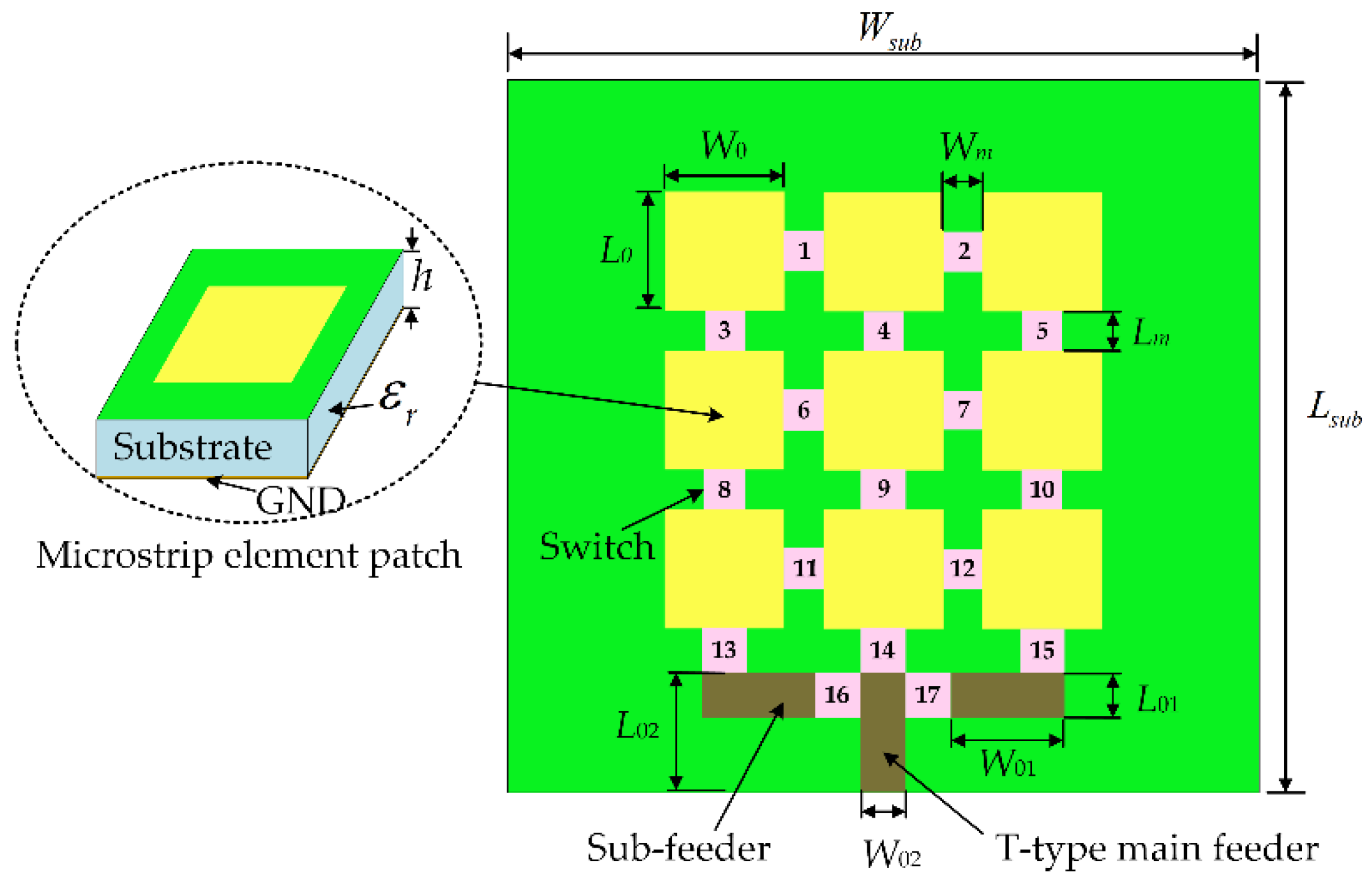


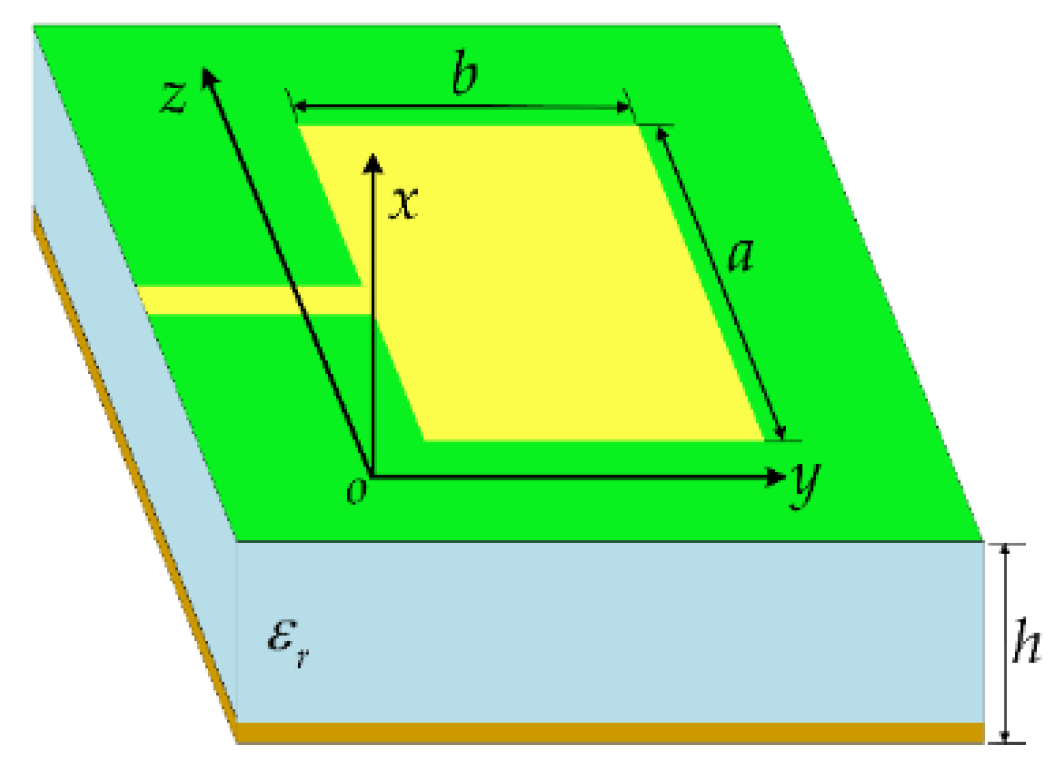


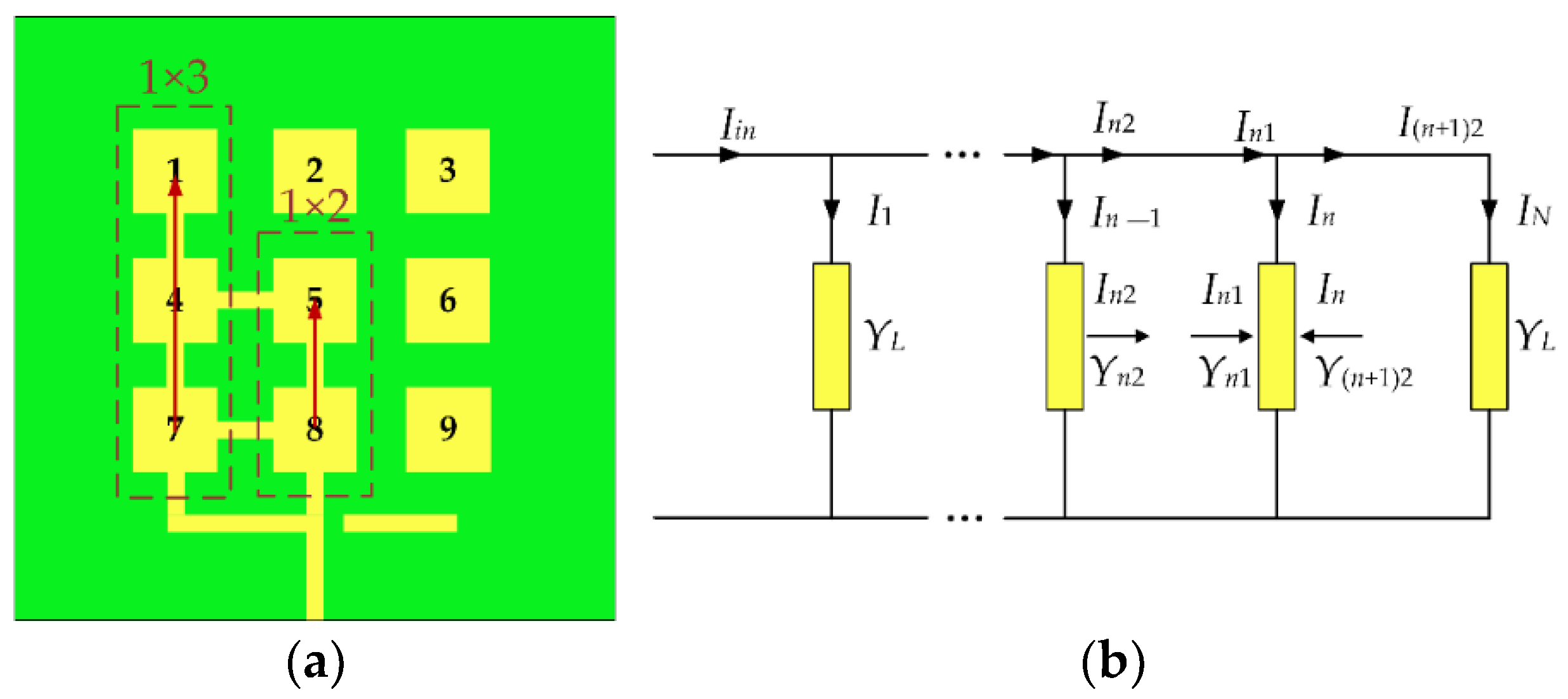

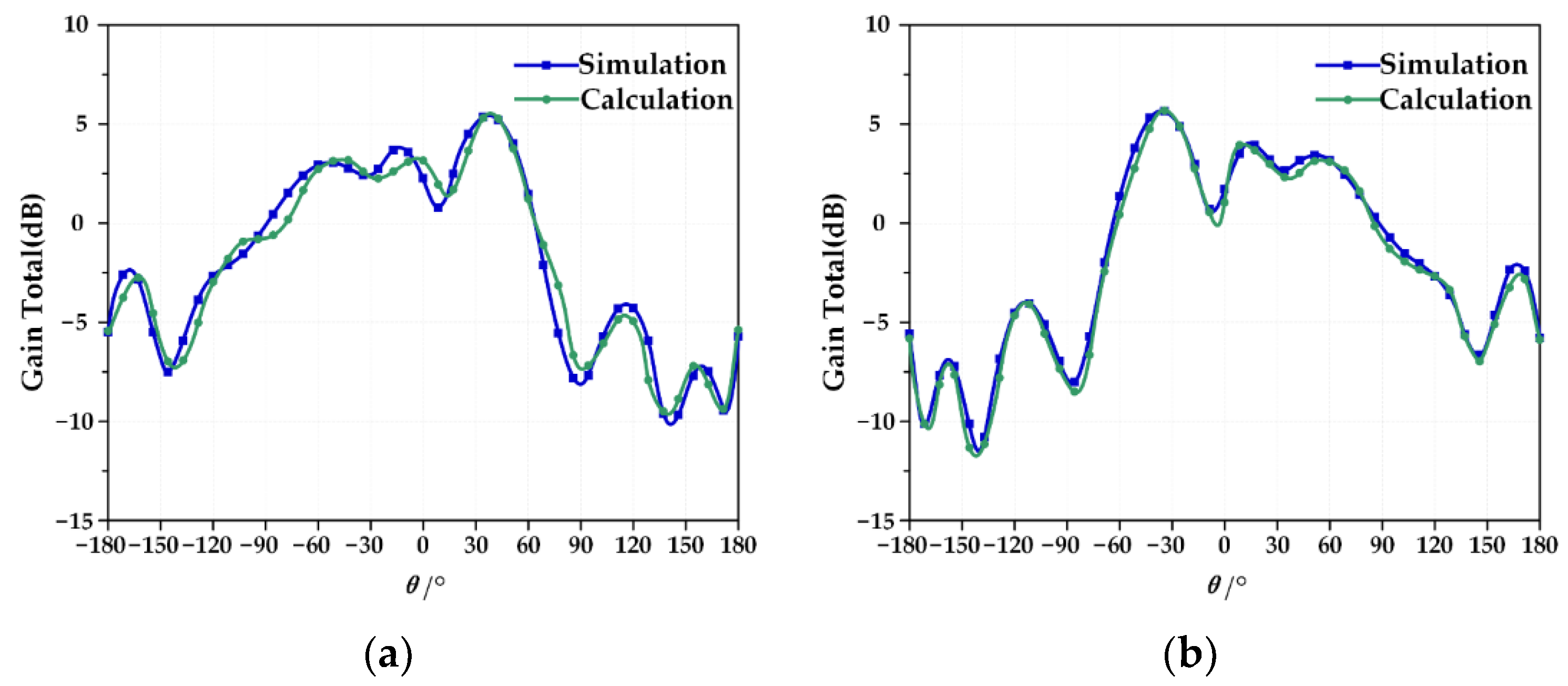





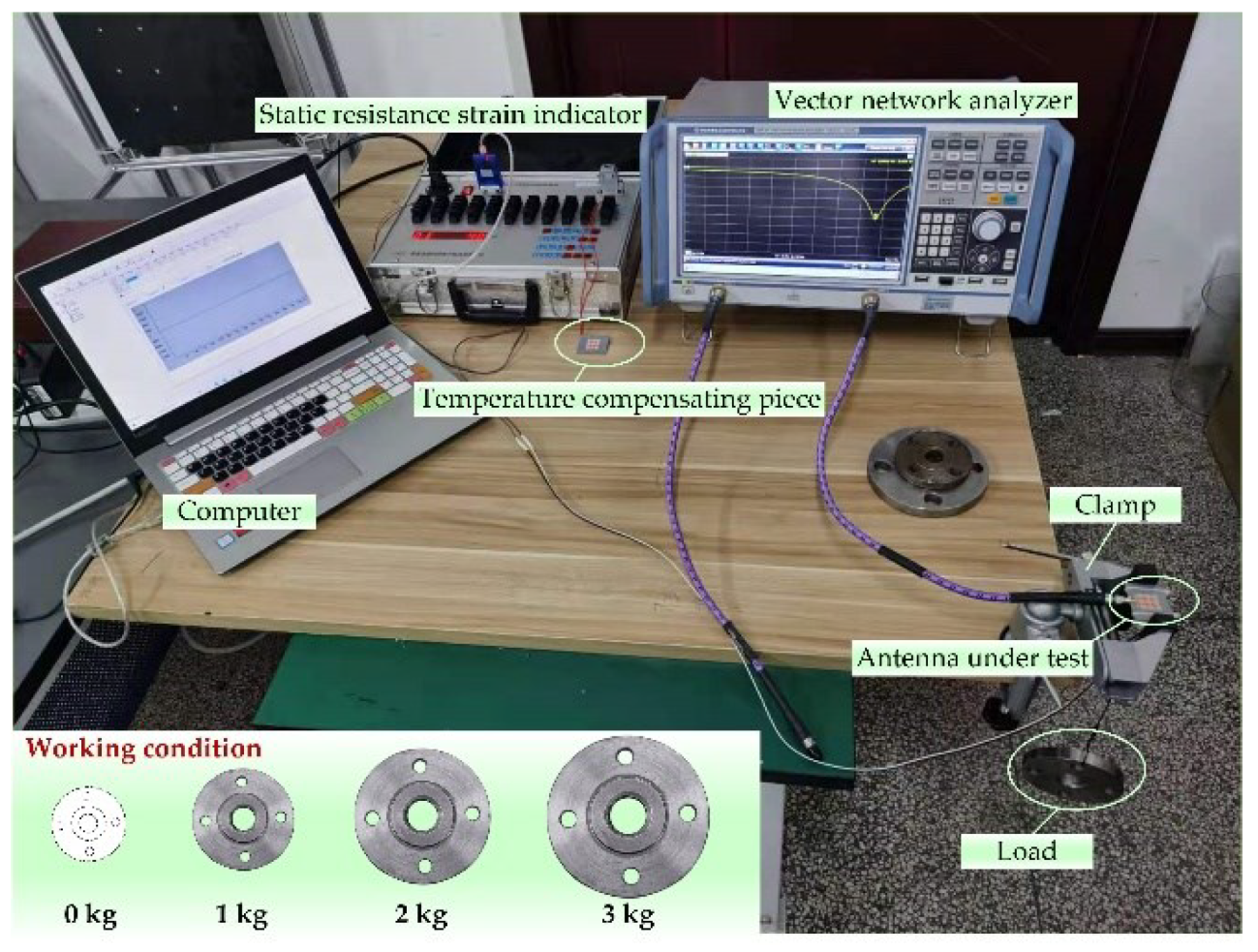

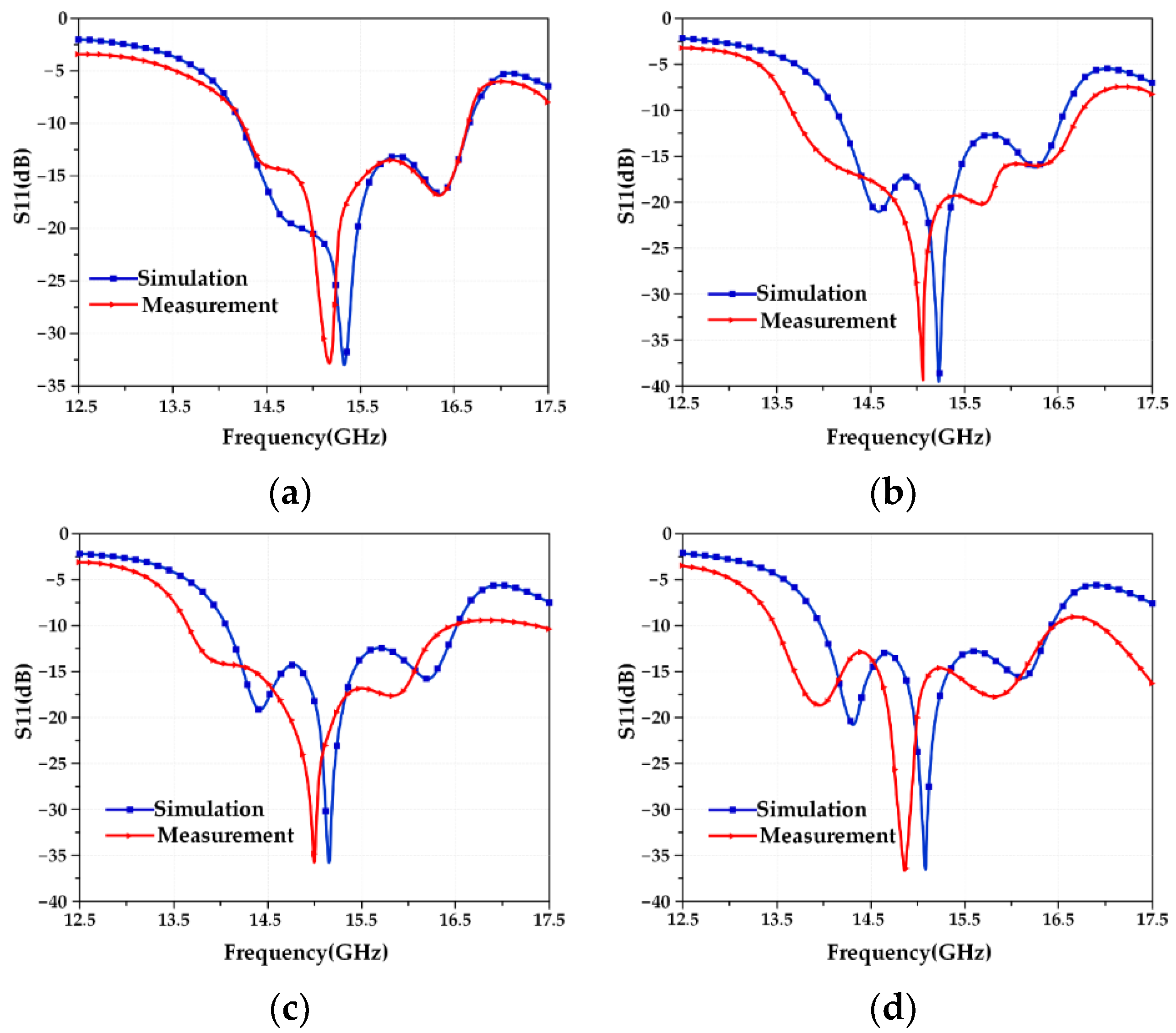
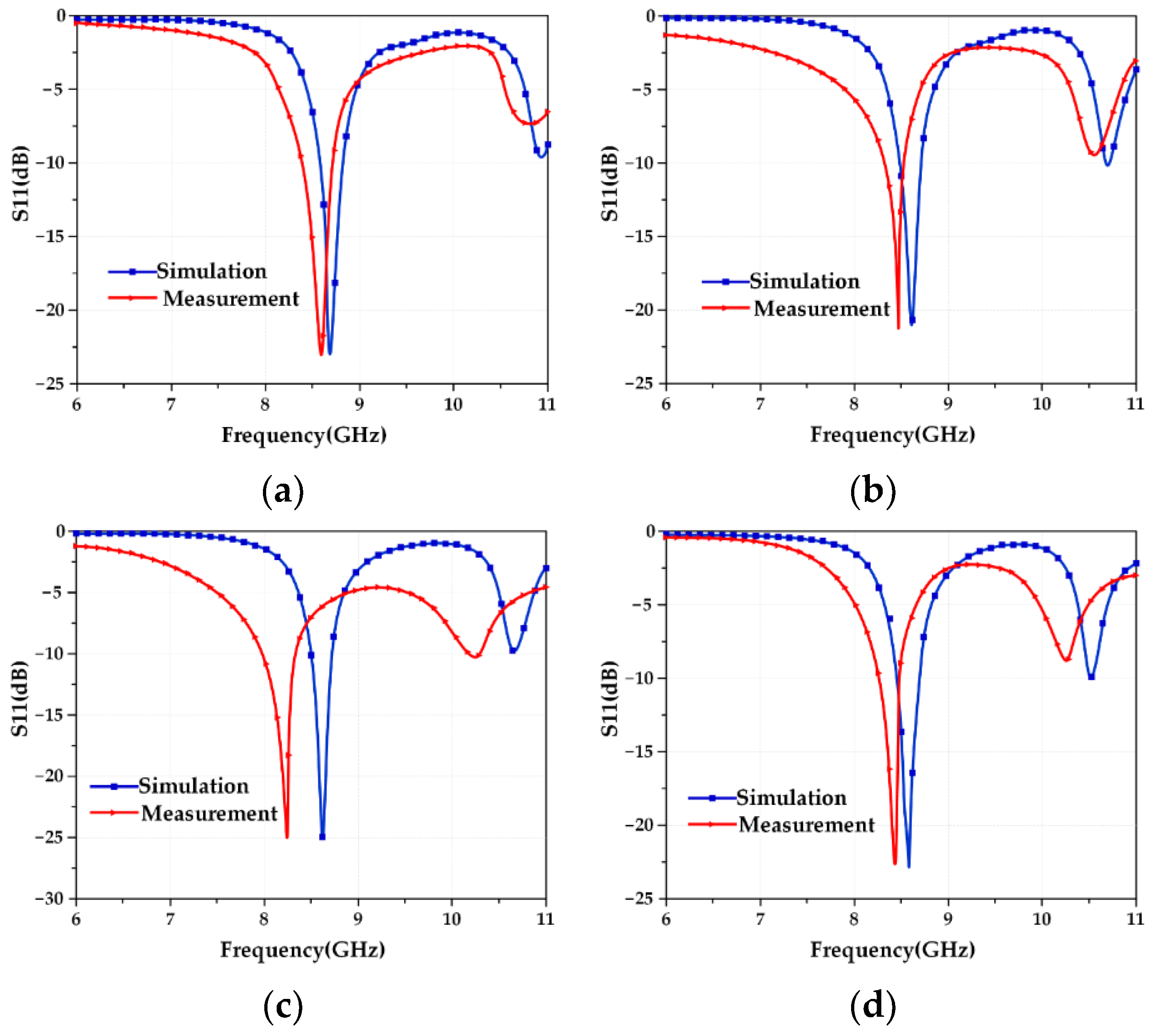
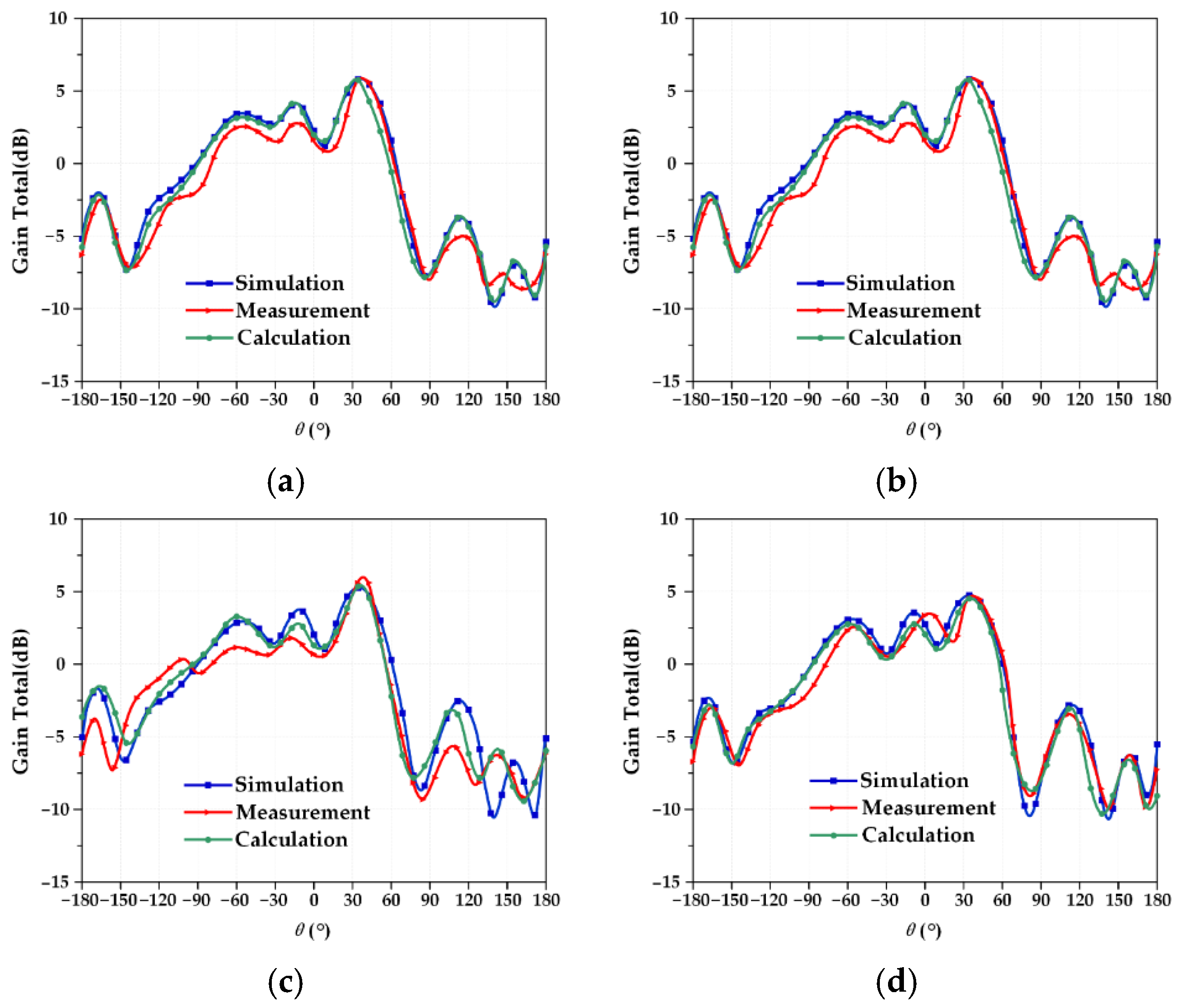

| Parameters | Value (mm) | Parameters | Value (mm) | Parameters | Value (mm) |
|---|---|---|---|---|---|
| L0 | 5 | W0 | 5 | Lsub | 32.5 |
| Wsub | 32.5 | Lm | 1.25 | Wm | 1.25 |
| L02 | 6.25 | W02 | 1.25 | L01 | 5 |
| W01 | 1.25 | h | 2 |
| Reconfigurable Antennas | Operating Frequency Bands (GHz) | Resonant Frequencies (GHz) | Beam Pointing (°) | Maximum Return Loss (dB) | HPBW (°) | Gain Total (dB) |
|---|---|---|---|---|---|---|
| Mode1 | 14.27–16.80 | 15.26 | −38 | −33.15 | 44.68 | 8.63 |
| Mode2 | 8.55–8.78 | 8.66 | −39 | −23.04 | 48.54 | 8.41 |
| Mode3 | 14.86–15.79 | 15.3 | +36.2 | −24.66 | 41.9 | 6.22 |
| Mode4 | 14.86–15.79 | 15.3 | −36.5 | −24.47 | 42.2 | 6.42 |
| Parameters | HFSS Simulation | Calculation |
|---|---|---|
| Resonant frequency f | 15.26 GHz | 15.16 GHz |
| Parameters | HFSS Simulation | Calculation |
|---|---|---|
| Resonant frequency f | 8.66 GHz | 8.86 GHz |
| Patch number | 1 | 2 | 3 | 4 | 5 | 6 | 7 | 8 |
| Current (A) | 0.02 | 0.2 | 0.4 | 0.5 | 0.3 | 0.01 | 1 | 1 |
| L0 (mm) (W0 = 5 mm) | HFSS Simulation f (GHz) | Model Calculation f (GHz) | W0 (mm) (L0 = 5 mm) | HFSS Simulation f (GHz) | Model Calculation f (GHz) |
|---|---|---|---|---|---|
| 4.5 | 15.98 | 16.23 | 4.5 | 15.94 | 15.23 |
| 4.6 | 15.82 | 16.08 | 4.6 | 15.88 | 15.22 |
| 4.7 | 15.66 | 15.84 | 4.7 | 15.82 | 15.21 |
| 4.8 | 15.52 | 15.61 | 4.8 | 15.76 | 15.19 |
| 4.9 | 15.40 | 15.38 | 4.9 | 15.72 | 15.18 |
| 5.0 | 15.26 | 15.16 | 5.0 | 15.26 | 15.16 |
| 5.1 | 15.52 | 14.95 | 5.1 | 15.16 | 15.15 |
| 5.2 | 15.30 | 14.74 | 5.2 | 15.04 | 15.14 |
| 5.3 | 15.12 | 14.54 | 5.3 | 14.96 | 15.13 |
| 5.4 | 14.96 | 14.35 | 5.4 | 14.84 | 15.12 |
| 5.5 | 14.8 | 14.16 | 5.5 | 14.68 | 15.11 |
| L0 (mm) (W0 = 5 mm) | HFSS Simulation f (GHz) | Model Calculation f (GHz) | W0 (mm) (L0 = 5 mm) | HFSS Simulation f (GHz) | Model Calculation f (GHz) |
|---|---|---|---|---|---|
| 4.5 | 9.24 | 9.67 | 4.5 | 8.82 | 8.90 |
| 4.6 | 9.12 | 9.50 | 4.6 | 8.80 | 8.89 |
| 4.7 | 9.0 | 9.33 | 4.7 | 8.76 | 8.89 |
| 4.8 | 8.88 | 9.17 | 4.8 | 8.72 | 8.88 |
| 4.9 | 8.80 | 9.02 | 4.9 | 8.72 | 8.87 |
| 5.0 | 8.66 | 8.86 | 5.0 | 8.66 | 8.86 |
| 5.1 | 8.58 | 8.72 | 5.1 | 8.64 | 8.86 |
| 5.2 | 8.45 | 8.58 | 5.2 | 8.62 | 8.85 |
| 5.3 | 8.38 | 8.44 | 5.3 | 8.58 | 8.85 |
| 5.4 | 8.26 | 8.32 | 5.4 | 8.56 | 8.84 |
| 5.5 | 8.16 | 8.19 | 5.5 | 8.52 | 8.83 |
| L0 (W0 = 5 mm) | Beam Pointing (°) | W0 (L0 = 5 mm) | Beam Pointing (°) | ||
|---|---|---|---|---|---|
| HFSS Simulation (°) | Model Calculation (°) | HFSS Simulation (°) | Model Calculation (°) | ||
| 4.5 | 31.8 | 35.5 | 4.5 | 31.9 | 34.1 |
| 4.6 | 32.1 | 35.6 | 4.6 | 32.7 | 34.5 |
| 4.7 | 33.3 | 35.7 | 4.7 | 34 | 34.9 |
| 4.8 | 33.3 | 35.8 | 4.8 | 34.6 | 35.2 |
| 4.9 | 34.9 | 35.9 | 4.9 | 35.4 | 35.6 |
| 5.0 | 36.2 | 36 | 5.0 | 36.2 | 36 |
| 5.1 | 37.6 | 36.1 | 5.1 | 36.8 | 36.4 |
| 5.2 | 40.3 | 36.2 | 5.2 | 38.1 | 36.8 |
| 5.3 | 42.7 | 36.3 | 5.3 | 36.7 | 37.2 |
| 5.4 | −11.6 | 36.4 | 5.4 | 37 | 37.6 |
| 5.5 | −9.4 | 36.5 | 5.5 | 36.7 | 38 |
| W0(mm) | 4.5 | 4.6 | 4.7 | 4.8 | 4.9 | 5.0 | 5.1 | 5.2 | 5.3 | 5.4 | 5.5 |
| Error (°) | 2.2 | 1.8 | 0.9 | 0.6 | 0.2 | 0.2 | 0.4 | 1.3 | 0.5 | 0.6 | 1.3 |
| Relative error (%) | 6.9 | 5.5 | 2.6 | 1.7 | 0.5 | 0.5 | 1 | 3.4 | 1.3 | 1.6 | 3.5 |
| L0(mm) | 4.5 | 4.6 | 4.7 | 4.8 | 4.9 | 5.0 | 5.1 | 5.2 | 5.3 | 5.4 | 5.5 |
| Error (°) | 3.7 | 3.5 | 2.4 | 2.5 | 1 | 0.2 | 1.5 | 4.1 | 6.4 | 48 | 45.9 |
| Relative error (%) | 11.6 | 10.9 | 7.2 | 7.5 | 2.8 | 0.5 | 3.9 | 10.1 | 14.9 | - | - |
| L0 (W0 = 5 mm) | Beam Pointing (°) | W0 (L0 = 5 mm) | Beam Pointing (°) | ||
|---|---|---|---|---|---|
| HFSS Simulation (°) | Model Calculation (°) | HFSS Simulation (°) | Model Calculation (°) | ||
| 4.5 | 27.2 | −36 | 4.5 | −31.4 | −34.5 |
| 4.6 | −32.3 | −36.1 | 4.6 | −33.7 | −34.9 |
| 4.7 | −33.1 | −36.2 | 4.7 | −35.1 | −35.3 |
| 4.8 | −33.7 | −36.2 | 4.8 | −34.3 | −35.6 |
| 4.9 | −36.5 | −36.3 | 4.9 | −35.7 | −36 |
| 5.0 | −36.5 | −36.4 | 5.0 | −36.5 | −36.4 |
| 5.1 | −37.9 | −36.4 | 5.1 | −36.8 | −36.7 |
| 5.2 | −39.7 | −36.5 | 5.2 | −37.9 | −37.1 |
| 5.3 | −43 | −36.6 | 5.3 | −37.3 | −37.5 |
| 5.4 | 12.8 | −36.6 | 5.4 | −35.8 | −37.9 |
| 5.5 | 10.1 | −36.7 | 5.5 | −36 | −38.2 |
| W0(mm) | 4.5 | 4.6 | 4.7 | 4.8 | 4.9 | 5.0 | 5.1 | 5.2 | 5.3 | 5.4 | 5.5 |
| Error (°) | 3.1 | 1.2 | 0.2 | 1.3 | 0.3 | 0.1 | 0.1 | 0.8 | 0.2 | 2.1 | 2.2 |
| Relative error (%) | 9.8 | 3.5 | 0.5 | 3.7 | 0.8 | 0.2 | 0.2 | 2.1 | 0.5 | 5.8 | 6.1 |
| L0(mm) | 4.5 | 4.6 | 4.7 | 4.8 | 4.9 | 5.0 | 5.1 | 5.2 | 5.3 | 5.4 | 5.5 |
| Error (°) | 63.2 | 3.8 | 3.1 | 2.5 | 0.2 | 0.1 | 1.5 | 3.2 | 6.4 | 49.4 | 46.8 |
| Relative error (%) | - | 11.7 | 9.3 | 7.4 | 0.5 | 0.2 | 3.9 | 8 | 14.8 | - | - |
| Working Condition | Size after Deformation (W0/mm) | Measurement Results (GHz) | Simulation Results (GHz) | Calculation Results (GHz) |
|---|---|---|---|---|
| 0 | 5.0 | 15.15 | 15.26 | 15.160 |
| 1 | 5.135 | 15.12 | 15.21 | 15.143 |
| 2 | 5.236 | 15.01 | 15.18 | 15.131 |
| 3 | 5.338 | 14.92 | 15.15 | 15.120 |
| Working Condition | Size after Deformation (W0/mm) | Measurement Results (GHz) | Simulation Results (GHz) | Calculation Results (GHz) |
|---|---|---|---|---|
| 0 | 5.0 | 8.55 | 8.66 | 8.861 |
| 1 | 5.131 | 8.51 | 8.63 | 8.852 |
| 2 | 5.234 | 8.37 | 8.59 | 8.856 |
| 3 | 5.336 | 8.49 | 8.57 | 8.840 |
| Working Condition | Size after Deformation (W0/mm) | Measurement Results (°) | Simulation Results (°) | Calculation Results (°) |
|---|---|---|---|---|
| 0 | 5.0 | 36.18 | 36.20 | 36.20 |
| 1 | 5.132 | 36.52 | 36.63 | 36.45 |
| 2 | 5.233 | 36.69 | 36.78 | 36.82 |
| 3 | 5.337 | 37.21 | 37.12 | 37.26 |
| Working Condition | Size after Deformation (W0/mm) | Measurement Results (°) | Simulation Results (°) | Calculation Results (°) |
|---|---|---|---|---|
| 0 | 5.0 | −36.48 | −36.50 | −36.4 |
| 1 | 5.133 | −36.71 | −36.66 | −36.76 |
| 2 | 5.232 | −37.12 | −37.03 | −37.23 |
| 3 | 5.336 | −37.36 | −37.15 | −37.65 |
| Reconfigurable Antennas | HFSS Simulation | Coupling Model Calculation |
|---|---|---|
| Mode 1 Antenna | 352.2 s | 0.026 s |
| Mode 2 Antenna | 324.6 s | 0.029 s |
| Mode 3 Antenna | 321.5 s | 0.880 s |
| Mode 4 Antenna | 312.8 s | 0.920 s |
Publisher’s Note: MDPI stays neutral with regard to jurisdictional claims in published maps and institutional affiliations. |
© 2022 by the authors. Licensee MDPI, Basel, Switzerland. This article is an open access article distributed under the terms and conditions of the Creative Commons Attribution (CC BY) license (https://creativecommons.org/licenses/by/4.0/).
Share and Cite
Xu, P.; Xu, X.; Lin, K.; Yu, R.; Zhang, D.; Wang, Y.; Wang, Z.; Yu, K.; Wu, W.; Ma, X.; et al. A Fast Evaluation Method for Electrical Performance of Frequency and Pattern Reconfigurable Microstrip Antenna Based on Electromechanical Coupling. Micromachines 2022, 13, 1412. https://doi.org/10.3390/mi13091412
Xu P, Xu X, Lin K, Yu R, Zhang D, Wang Y, Wang Z, Yu K, Wu W, Ma X, et al. A Fast Evaluation Method for Electrical Performance of Frequency and Pattern Reconfigurable Microstrip Antenna Based on Electromechanical Coupling. Micromachines. 2022; 13(9):1412. https://doi.org/10.3390/mi13091412
Chicago/Turabian StyleXu, Pengying, Xiaoxian Xu, Kabin Lin, Rong Yu, Daxing Zhang, Yan Wang, Zhihai Wang, Kunpeng Yu, Wenzhi Wu, Xiaofei Ma, and et al. 2022. "A Fast Evaluation Method for Electrical Performance of Frequency and Pattern Reconfigurable Microstrip Antenna Based on Electromechanical Coupling" Micromachines 13, no. 9: 1412. https://doi.org/10.3390/mi13091412
APA StyleXu, P., Xu, X., Lin, K., Yu, R., Zhang, D., Wang, Y., Wang, Z., Yu, K., Wu, W., Ma, X., & Wang, C. (2022). A Fast Evaluation Method for Electrical Performance of Frequency and Pattern Reconfigurable Microstrip Antenna Based on Electromechanical Coupling. Micromachines, 13(9), 1412. https://doi.org/10.3390/mi13091412









